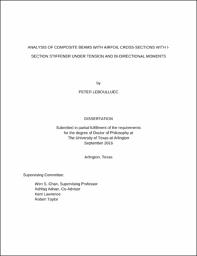
ATTENTION: The works hosted here are being migrated to a new repository that will consolidate resources, improve discoverability, and better show UTA's research impact on the global community. We will update authors as the migration progresses. Please see MavMatrix for more information.
Show simple item record
| dc.contributor.advisor | Chan, Wen | |
| dc.contributor.advisor | Adnan, Ashfaq | |
| dc.creator | LeBoulluec, Peter Louis | |
| dc.date.accessioned | 2019-07-17T16:36:40Z | |
| dc.date.available | 2019-07-17T16:36:40Z | |
| dc.date.created | 2016-08 | |
| dc.date.submitted | August 2016 | |
| dc.identifier.uri | http://hdl.handle.net/10106/28371 | |
| dc.description.abstract | Annual wind power generation capacity in the US has increased from 3 gigawatts in 2000 to 61 gigawatts in 2013 and is on track to fulfill 20% of projected U.S. electricity needs (305 gigawatts) by 2030. To enable the increase in electricity generation of wind turbines, longer blades are being designed which require improved engineered blades to handle higher loads. Thus, the wind turbine industry is turning to the use of carbon-epoxy composite materials to take advantage of their low weight yet high strength ratio and improved fatigue resistance. Current analyses to design turbine blades utilize either Finite Element Analysis programs, which are time consuming and costly for conducting parametric studies in the preliminary design stage, or use analytical solutions which are inaccurate or too complex.
In this research, an analytical model based on Narrow Beam Theory, a modification of Classical Lamination Theory, will be made and coded into MATLAB to quickly conduct structural analyses on portions of composite turbine blades with airfoil cross-sections. Various laminate layups can be studied with the current model as well as various airfoil cross-sections. This analysis will predict the structural stiffnesses and stresses and strains in individual composite plies of airfoil blades with and without I-beam stiffeners under axial and bending loads. Results will be validated using ANSYS FEM and with experimental specimens. The experimental work consists of fabricating laminates to obtain basic material properties and fabricating uniform airfoil wings to conduct a transversely loaded bending test to find flap-wise bending stiffness.
I-beams will also be analyzed separately from airfoil cross-sections to understand their stiffness and stress characteristics and to investigate Narrow Beam Theory. Thus, by enabling a quick and simple, yet accurate static analysis on composite turbine blades, improved initial designs can be determined in an early design phase to allow more efficient, reliable, and economical turbine blades to be made. | |
| dc.format.mimetype | application/pdf | |
| dc.language.iso | en_US | |
| dc.subject | Composite beams | |
| dc.subject | Airfoil turbine blade | |
| dc.subject | I-beam | |
| dc.title | ANALYSIS OF COMPOSITE BEAMS WITH AIRFOIL CROSS-SECTIONS WITH I-SECTION STIFFENER UNDER TENSION AND BI-DIRECTIONAL MOMENTS | |
| dc.type | Thesis | |
| dc.degree.department | Mechanical and Aerospace Engineering | |
| dc.degree.name | Doctor of Philosophy in Mechanical Engineering | |
| dc.date.updated | 2019-07-17T16:36:40Z | |
| thesis.degree.department | Mechanical and Aerospace Engineering | |
| thesis.degree.grantor | The University of Texas at Arlington | |
| thesis.degree.level | Doctoral | |
| thesis.degree.name | Doctor of Philosophy in Mechanical Engineering | |
| dc.type.material | text | |
Files in this item
- Name:
- LEBOULLUEC-DISSERTATION-2016.pdf
- Size:
- 10.68Mb
- Format:
- PDF
This item appears in the following Collection(s)
Show simple item record


